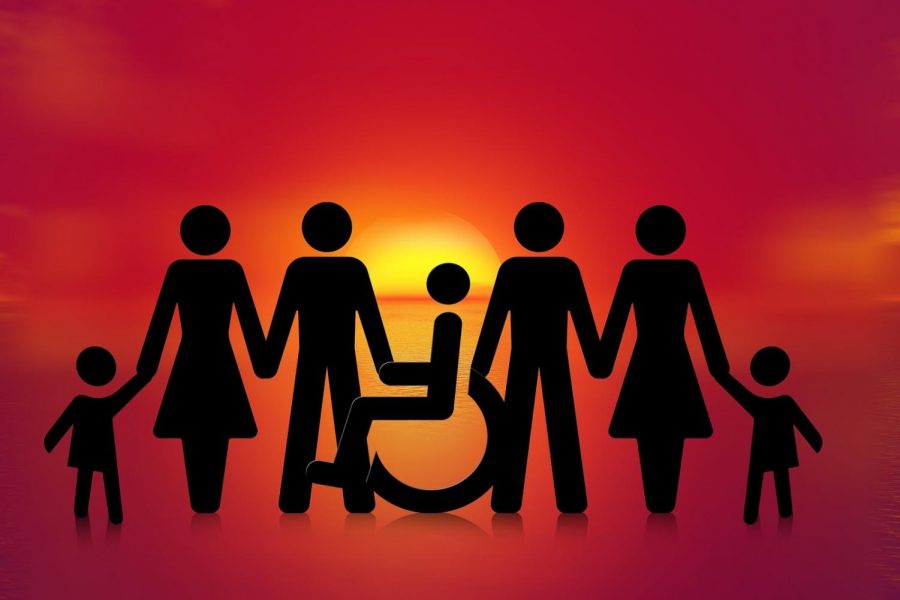The Ongoing Struggle of Social Injustice for People With Disabilities
Opinion
America has a long history of neglecting the rights and lives of people with disabilities. While attempts have been made to amend this in the past, a more drastic change is needed if we want to live cooperatively as a society. Photo courtesy of Geralt
October 3, 2020
As a nation with inalienable human rights, the U.S. needs to get better at recognizing people with disabilities. In the U.S. alone, there are 61 million adults who live with a disability. Only 41 percent of the disabled people within the working age (21-64) are employed. 10 percent of people with severe disabilities live in persistent poverty.
Social injustices for people with disabilities were brought into the spotlight in the 1900s. In the 1800s, people with special needs were put into circuses for entertainment purposes. They were thought as, “abnormal,” and, “fun to look at.” It wasn’t until the Smith-Sears Act, also known as the Soldiers Rehabilitation Act of 1918, when disabled people started getting some equality. This act provided services to veterans disabled during World War I and led to the field of occupational, physical, and speech rehabilitation therapy. The Red Cross Institute for Crippled and Disabled Men was the first institution dedicated to treating amputees who had suffered from the war. They received medical treatment and special training so that they could support themselves. In 1943, this law was extended to all disabled citizens.
By the 1960s, the Disability Rights Movement was created. Advocates spoke up about equal opportunities for people with disabilities. People demanded for children to be taken out of institutions and asylums, and to be placed in regular schools. It wasn’t until 1990, when the Americans with Disabilities Act (ADA) was passed, that equal treatment and access for people with disabilities was guaranteed. Discrimination was banned in employment, state and local governments, transportation, and telecommunications services.
In 2010, the Equality Act was passed, making it illegal for businesses to discriminate against people with disabilities. However, many businesses have found loopholes in this law. Section 14 of the Fair Labor Standards Act allows employers to pay subminimum hourly wages to disabled people. One of the biggest contributors to this social injustice is Goodwill. In their mission statement, Goodwill states that their goal is to help all people, “reach their full potential.” Yet this doesn’t apply to all employees- according to Labor Department records, Goodwill pays thousands of disabled employees subminimum wage, as low as 22 cents an hour. This should be reevaluated, since having a disability shouldn’t correlate to a reduced minimum wage.
“This salary cap forces me to decide between my job and my health, a decision that really isn’t a choice at all,” Heather Tomko said to Public Source. “If I want to apply to a job, I have to look not only at the lower limit of a salary range, but the upper one too. If I lost my services, I’d end up losing my job, too, as I can’t get to work without those services. I’d be right back where I started.”
As a disabled person, there are many benefits one can receive. The Supplemental Security Income (SSI) gives money to disabled people based on their financial need. The Social Security Disability Insurance (SSDI) is a social insurance program that funds people who are unequipped to work. However, these benefits provide insufficient care. In 2019, Social Security paid an average of $1,234 per month to all disabled workers. This is barely above the 2018 poverty line income of $12,140 annually. For many disabled people unequipped to work, these benefits represent their whole income.
“It’s almost impossible for people to self-finance the services and support they need, unless they are extremely wealthy,” Director of Government Affairs for the National Organization of Social Security Claimants’ Representatives (NOSSCR), Lisa D. Ekman, said. “This is literally a life or death decision for people. Private insurance does not cover them, so Medicaid is the only source for people to get those services and supports.”
Aside from low income rates, disabled people also feel a huge burden choosing between marriage and their benefits. Getting married increases the likelihood of a disabled person losing their SSI and SSDI benefits. This is often called the “marriage trap.” Because of Social Security’s strict income limits, if a disabled person’s spouse makes more than $392 per month, they become ineligible to receiving benefits. If both spouses receive benefits, the SSI income will also decrease. On average, SSI provides a $783 limit for each person, while a couple with both people receiving benefit’s income is decreased to approximately $1,175 total.
As a country, we should take positive action and address the underrepresentation and disadvantages that people with disabilities receive. Everyone should be given equal opportunities and rights, not just people without disabilities.




eastyn • Mar 2, 2023 at 1:19 pm
ugh yes
Zyro • Apr 29, 2022 at 7:31 am
Helped me with my school essay/ poem. Thanks 🙂
Elaine Bayer • Oct 9, 2020 at 1:10 pm
Thank you for this article. I am the transition teacher at Westwood HS. As part of the team, job coach, Michelle Lyon does an excellent job in finding paid employment for our students. Some of our community partners are; Whataburger 620 at Lakeline; Cover2 Restaurant, Chili’s, Ross, Old Navy, TJ Maxx, Burlington, and Goodwill ( and yes what you reported regarding Goodwill is unfortunately the norm–it really depends on the manager of the store); The Main Event; HEB; Willis-Permian Movers; Favor to name a few.